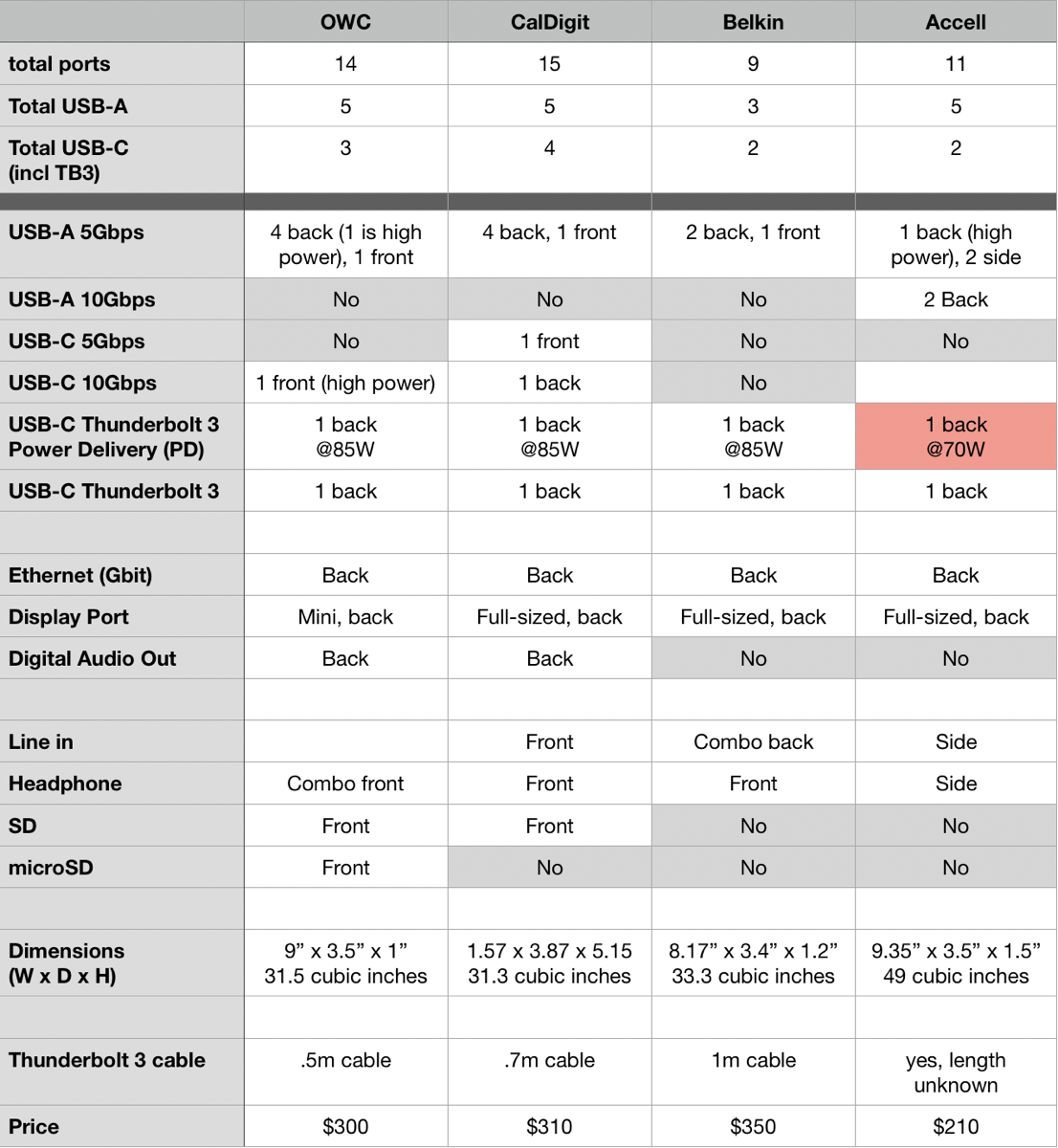
Every once in a while I find myself descending into madness when I work on a review. Remember when I got curious about exactly what the government regulations were about banks and using SMS for two-factor authentication? That was our fun trip into NIST Special Publication 800-63B. Well this time I’m trying not to go down as far but it’s a challenge.
The subject is Thunderbolt 3 docks. I’m on my fourth one now and I think the more I look at them, the more details I notice, which causes me to do more research which causes me to want to share what I learn with you. Before I dig in, I wanted to let you know that I’ve included a comparison of the four docks with everything from ports to speed to cost to size. I’ve also got links to all of the docks so you can see more about them. Ok, now we can get started.
You may remember that I reviewed the Belkin Thunderbolt 3 dock in January of last year, under the headline, Thunderbolt Docks – Just Because You Can Plug It In Doesn’t Mean it Will Work. That was the beginning of my adventure. I liked the Belkin Thunderbolt 3 dock, but at the time, I didn’t realize that there were much better docks available.

I received the Accell Thunderbolt 3 dock as a review unit and told you about it in the article entitled Accell Thunderbolt 3 Dock – More Ports for Less Money. Where the Belkin has 9 ports, the Accell has 11. It’s not just counting total ports that matters though. I liked the Accell because it had 5 USB-A ports where the Belkin only had 3. My opinion on dock comparisons was nearly entirely determined by how many USB-A devices I needed to plug in.
One thing (amongst many) that I didn’t understand was the importance of the Power Delivery of a dock. I didn’t notice that the Accell only provides 70W of power over Thunderbolt 3 while the Belkin provides 85W which is enough to power a 15″ MacBook Pro. You can charge a 15″ at 70W but it takes longer.
There’s more I didn’t understand but we’re going to keep moving and circle back.
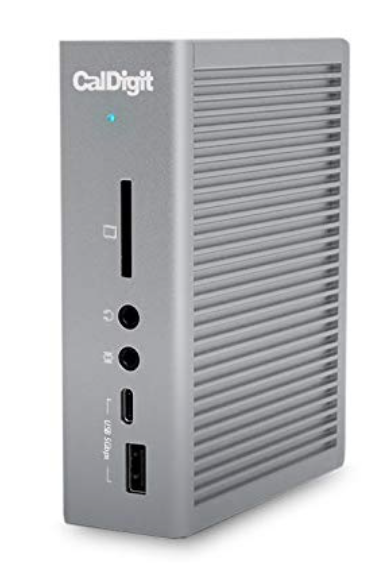
The next dock I tested was the CalDigit TS3+ and I fell in love with this dock. I called my review CalDigit TS3+ Thunderbolt 3 Dock – More Ports, More Money, More Better. This little power house has 15 total ports, 5 of which are USB-A and it had 4 USB-C where the previous docks only had 2 USB-C. As time has passed since the first dock review, I’ve gained more USB-C devices so having 4 is a big advantage. It does provide the full 85W of Power Delivery.
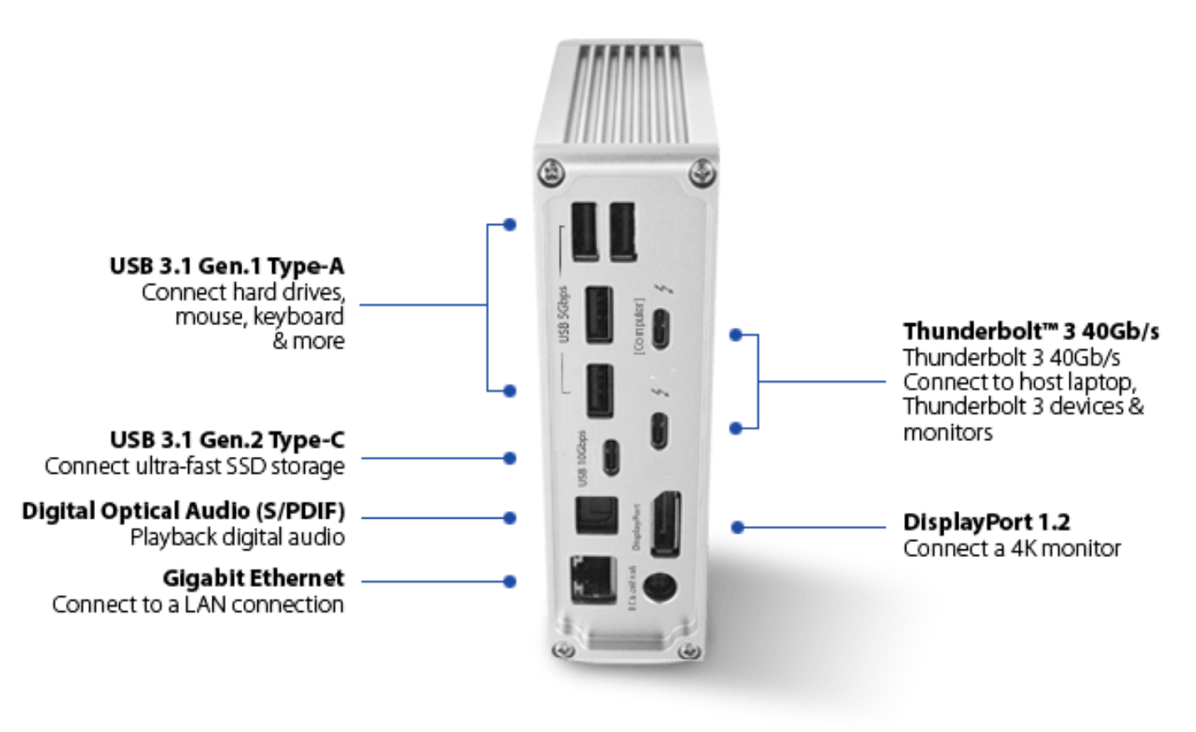
The form factor of the Belkin and Accell docks was a long flat box with most of the ports on the back. Belkin and Accell’s docks are 8 and 9 inches wide respectively and 3.5 inches deep, so they take up a lot of space on your desk. On the front, the Belkin only has one USB-A port and the headphone jack, while the Accell has no ports on the front at all, and instead has 2 USB-A ports and the headphone jack on the side. On both docks, you pretty much have to lift it up and yank it around to get to any of the ports on the back.
In contrast, the CalDigit is nearly the same volume as the other two docks, but instead of being a long, flat box, it stands on edge and only takes up 1.6″ x 4″ of desk space. That alone makes me love the CalDigit a lot. But it also has a USB-A, USB-C, headphone jack and an SD card slot all on the front. With this much on the front, I can keep the permanent things plugged into the back, like my camera and microphone, but keep some temporary cables lying around for on-the-fly connectivity to the dock. It works really, really well for me.
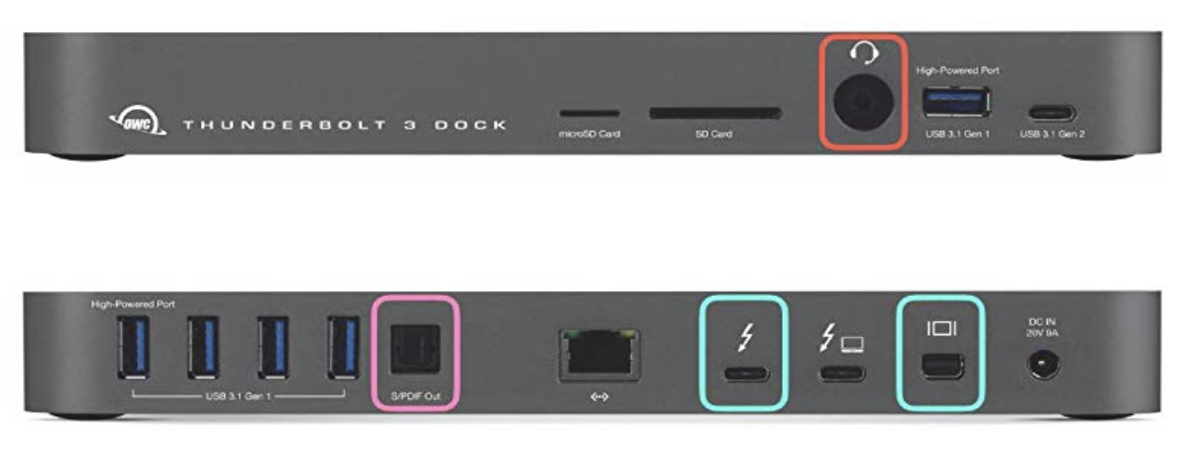
But that didn’t keep me from having a wandering eye towards the OWC 14-Port Thunderbolt 3 dock that CEO Larry O’Connor told us about at CES. I asked him for a review unit and it arrived a few weeks ago but I’ve just now gotten the time to check it out.
The OWC dock is a long, flat box like the first two I’d tested, at 9″ wide, 3.5″ deep and an inch tall. Like the label on the tin, it has 14 ports, 5 of which are USB-A and 4 of which are USB-C. Remember, the letters mean shape, not speed or even protocol. Of the 4 USB-C ports on the OWC, 2 are USB only, and the other two are Thunderbolt 3 which means they can deliver just about anything. Thunderbolt 3 can be video, it can be audio, it can be data, it can be Ethernet; just pick whatever you want.
It was in studying the specs of the OWC dock that I really started to learn more about the ports than I’d dug into before. I built a table in Numbers trying to compare the four docks and it started to get very complicated.
Each of the docks I’d tested had silk-screened information on each port trying to indicate the type of port and what it was for. For example, on the OWC dock, there’s a USB-C port on the back that has a lightning bolt and a little icon of a computer. The lightning bolt designates it as Thunderbolt, and the icon of the computer tells you this is the port for Power Delivery. This is where you want to plug in your computer so it charges. But this is also the port through which all of the signals will go to the other ports on the dock. Very important that you plug into the right port, using a Thunderbolt cable (we’ll get more into cables later.
Some of the docks had USB-A ports with a little SS next to them. Some said 5Gbps next to their USB-A ports. The Accell dock had 2 USB-A ports with SS next to the USB symbol and then a 10. The OWC dock says USB 3.1 Gen 1 next to the USB-A ports on the back and front, but one of the USB-C ports says USB 3.1 Gen 2, and the CalDigit has both Gen 1 and Gen 2 USB-C ports. So what the heck is going on here? What’s SS? Why do some SS ports say 10 next to them? What’s USB 3.1 Gen 1 vs. Gen 2? How the heck can we compare all of this?
I’m going to try desperately to untangle this, then I’m going to tangle it all back up when I’m done. I’m also going to blame the people who have written the USB spec because they clearly think that obfuscating information will make their jobs secure. I remember firing someone for that one time. But anyway…
USB 3 is a hot mess, as you’ve just heard. At the severe risk of oversimplifying things, I’m going to give you some synonyms to work with. USB 3.1 Gen 1 is capable of transferring data at 5Gbps, while USB-3.1 Gen 2 is capable of 10Gbps. So far so good. SS stands for SuperSpeed, and SS is the same as Gen 1, or 5Gbps. None of the docks I have tested showed it but you might see SS+ which actually means Gen 2 or 10Gbps. Ok, with me so far? Great. Now let’s get lost again.
We have enough information to really compare the docks now, but just to make sure you leave unhappy and confused like I am, let’s change all of this. Turns out the evil people at the USB Promoter Group have renamed things, ostensibly for clarity. That’s funny right there.
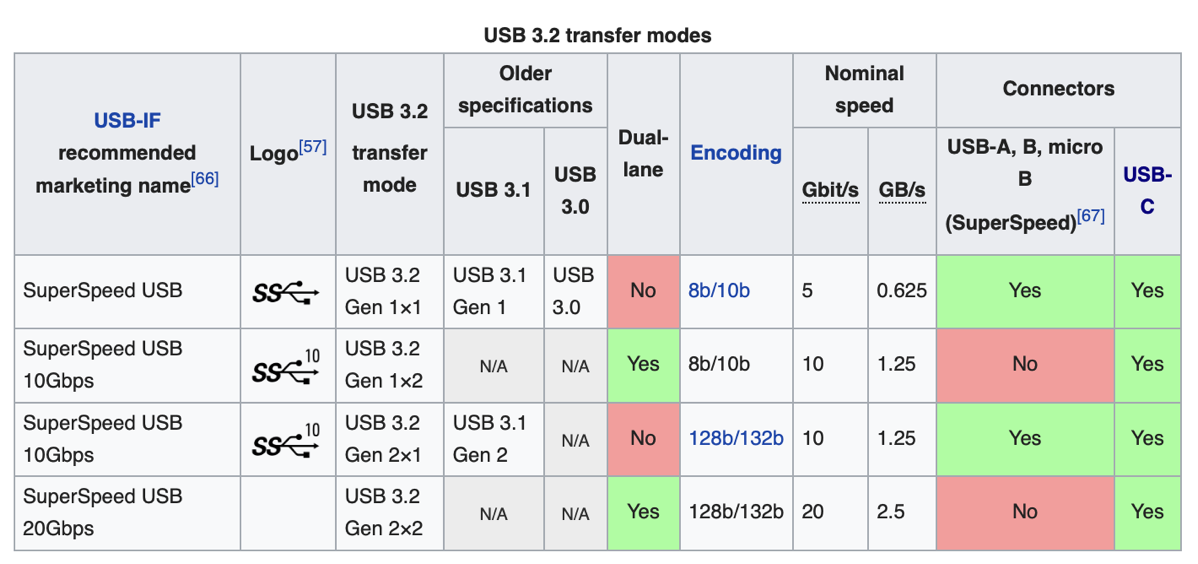
The new spec is called USB 3.2. Our old friend SuperSpeed, capable of 5Gbps, previously known as USB 3.1 GEN 1 is now called USB 3.2 Gen 1×1. I swear, I’m not making this up. When Steven Goetz explained this all to me, I told him I was going to kill myself. But let’s keep going because it gets worse.
10Gbps, formerly known as USB 3.1 GEN 2, is now called USB 3.2 Gen 2×1. Very helpful, right? And finally, we have USB 3.2 Gen 2×2 which is now 20Gbps! At least we got some speed improvements with this new spec, right? I put a copy of a table from Wikipedia and a link to the explanation into the shownotes so you can see what I’m talking about in all its glory.
As I said, I told you this part of the story just to make sure you’re as annoyed as I am. And guess what else? Just this week, it was announced that USB 4 is coming, probably finalized before the end of the year and will bring us 40Gbps! I really don’t care about the speed. If they just simplify the naming convention I’ll be happy!
I have had four docks in the last year or so and none of them have used this nonsense USB 3.2 spec so we’ll go back to simpler times. Let’s just talk 5 vs 10Gbps for now, no SS, no Gen this Gen that nonsense, ok?
This was originally intended to be a review of the OWC Thunderbolt 3 dock so let’s get back to it, now that we are better equipped on how to even compare the docks. The OWC dock has quite a few ports on the front which is awesome. It not only has the beloved SD card slot, it’s even got a Micro SD card slot, which is great for people with GoPros and other action cameras. I don’t think it’s essential since most people use the little carriers for Micro SD cards so they don’t lose them, but it’s a nice touch.
It’s also got a combined headphone/microphone jack on the font which means you can plug in a headset mic and annoy your friends while gaming, or participate in conference calls. There’s a 5Gbps USB port on the front, which also says “high powered’. The graphic from the OWC website shows a phone and a tablet charging from it so it’s probably at 1.5A. There’s also a 10Gbps USB port.
Charge a device, plug in an SD card, use a headset, these are the perfect ports to put on the front of a dock. OWC really thought this out well.
On the back, the OWC dock has four 5Gbps USB-A ports, one of which is high power. You’ll have to just memorize that it’s the one on the end because, like all of the docks except for the CalDigit, it’s really hard to pick them up and see the back when you have everything plugged in.
The OWC dock also has digital audio out like some of the other docks. There are two USB-C/Thunderbolt ports, both with the lightning symbol, but one has that little computer symbol too so you know where to plug in the computer. It has a Mini DisplayPort connector that can support a 4K monitor at 60Hz and of course the Thunderbolt 3 port can support a 4K or 5K monitor. I have the 5K LG monitor plugged into the Thunderbolt 3 port on the OWC and it works great. One of the joys of Thunderbolt is that you can daisy chain devices, so my LG display also serves as a Thunderbolt hub to more devices.
I know you’re tired of the discussion of speeds, but we have to bring it up yet again. Thunderbolt 2 can deliver 20Gbps, while Thunderbolt 3 can deliver 40Gbps. But get this, if you’ve got a Thunderbolt 3 port in a device, but you use a Thunderbolt 2 cable, you’re only going to get the 20Gbps of Thunderbolt 2!
The reason I was compelled to learn about this was that the OWC dock comes with a ludicrously short Thunderbolt cable and I wondered why. The Belkin came with a 1m cable, the CalDigit with a shorter 0.7m cable, but the OWC is the shortest at 0.5m. Because the cable is so darn short, I have to put the dock on the right side of my monitor to get it close enough to barely reach my MacBook Pro. It’s so much in the way that I had to stack my microphone’s USB interface and my drink coaster on top of it.
I started looking into the prices on Thunderbolt 3 cables and they’re really expensive! Even if you shop at Monoprice, a 1m Thunderbolt 3 cable is $47 where the same length in Thunderbolt 2 is only $20.. From what I’ve seen, only CalDigit puts a little “3” on their Thunderbolt cables so you know which ones not to loan out!
When I was talking to Steven Goetz about this, he tried to help me understand whether we really care about all of these speeds. USB at 5 and 10Gbps, Thunderbolt at 20 and 40Gbps, who needs it?
He knows that I bought the Samsung T5 SSD as a backup drive so he used that as the baseline to make the case. The T5 is a very fast SSD, clocking in at 540MBps transfer rate. To compare this to the USB and Thunderbolt speeds, we need to change bytes into bits.
There are 8 bits in a byte so 540MBps is 540 x 8 = 4320mbps, or 4.3Gbps. That means that after all of this faffing about with specs and speeds, even the slower 5Gbps USB 3.1 Gen 1 ports are faster than this wicked fast SSD!
What this tells me is that the speeds of Thunderbolt 3 are really for people pushing lots more data than a normal user like me. Real-time video recording comes to mind or writing to 2 SSDs or more at the same time.
What matters to me, and what matters I suspect to most of you high-end nerds is lots of ports. Soon you’ll care deeply about USB-C ports, but for now, I bet most of you care about lots of USB-A ports the most.
Bottom Line
Of the four docks I’ve tested and analyzed, the Belkin dock is the one I would avoid. It has the fewest ports at only 9, and it’s the most expensive of them all at $350.
The Accell dock with 11 ports is on sale right now, running only $210 on Amazon if you simply check the box for the $40 off coupon.
If you need a lot of ports, and you want the right ports on the front and you don’t mind the big flat form factor, OWC’s 14 port Thunderbolt 3 dock for $300 on Amazon is a great option. If you can live with the paltry 20Gbps speeds of Thunderbolt 2, I’d buy a longer cable to give you more flexibility on where it sits on your desk. The OWC 14 Port Thunderbolt 3 dock will actually be perfect for Steve to replace the Belkin Thunderbolt 3 dock he’s been using.
I’m still going to stick with the CalDigit for me though. With the most ports including one more USB-C port than any of the others, plus having the right ports for me on the front, and having that tiny little footprint on my desk, the CalDigit TS3+ for $310 on Amazon is the winner for me.


Hi Allison — Yes, I agree with your evaluation. I did a similar comparison back in November and purchased the CalDigit Thunderbolt Station 3 Plus from Amazon (it’s Amazon Prime eligible for free shipping and the 5% rebate from the Amazon Prime Store Card, and it can be shipped to an Amazon locker in a neighboring state where there is no sales tax).
My TS3+ came with the .7mm Thunderbolt 3 cable. I just checked CalDigit’s online U.S. store and this cable sells for $22.99. They also list a 2m (6.56 feet) cable for $49.99 (currently backordered with an estimated delivery availability in 4 to 6 weeks). There is another difference between these two cables other than their length that explains why longer Thunderbolt 3 cables are more expensive. The shorter cable is PASSIVE and the longer cable is ACTIVE. CalDigit provides some very helpful guidance regarding use of Thunderbolt 3 cables in the product description for the longer cable:
”ACTIVE Thunderbolt 3 cable offers superior signal quality and strength for longer cables. (NOTE: Active cables do not support USB3.0 & USB3.1. Only USB2.0.)”
Also:
”USING THIS CABLE WITH A THUNDERBOLT 3 DEVICE
ACTIVE Thunderbolt 3 cables offer full performance when used directly with a Thunderbolt 3 device such as a dock or hard drive. If you’re intending on using this cable with a Thunderbolt 3 dock you will get FULL performance out of the dock including FULL performance from the USB 3.0 and USB 3.1 ports on the dock.
USING THIS CABLE WITH A USB-C DEVICE (NON-THUNDERBOLT 3)
If you’re directly connecting an ACTIVE Thunderbolt 3 cable to a NON-Thunderbolt 3 device such as a USB-C (USB 3.0 or USB 3.1) hard drive you will see reduced performance (USB 2.0). If you require full backwards compatibility from your Thunderbolt 3 cables please purchase a PASSIVE cable that offers full speed USB 3.0 and USB 3.1 backwards compatibility.”
Now we know why manufacturers deliver short cables with their Thunderbolt 3 docks… they are PASSIVE to ensure backwards compatibility with more devices.
CalDigit’s product description for their shorter PASSIVE Thunderbolt cable also provides interesting guidance:
”Extreme Performance for Pro Users! High quality Thunderbolt 3 Cable that supports full 40Gb/s Thunderbolt 3 speeds. (NOTE: Some other Thunderbolt 3 cables may support only 20Gb/s. Please verify spec.)
One of the few cables on market to support up to 100W Power Delivery / Laptop charging, 5 Amp / 20V. (NOTE: Some other Thunderbolt 3 cables are rated up to 60W only.)”
It’s also interesting that CalDigit’s Thunderbolt 3 cables are certified by Intel and they are warrantied for 2 years.
I do believe most people consider cost and fit when purchasing a cable. Who the hell considers whether a cable is ACTIVE or PASSIVE, or how much power delivery the cable will support? And as you report in this article, USB naming specs suck big time. When USB 3.2 was announced I tried to complain about the naming mess to the organization responsible — the USB-IF (USB Implementers Forum, Inc.) — but there is no email address or phone number or other contact information listed on their website (www.usb.org)!
I am now carefully labeling my USB and Thunderbolt 3 cables that have USBC connectors. I include the vendor of the cable so I know where it came from.
What I’d like to be able to do is plug a cable into a USBC port on my computer and run an app named Cablespec to view the specs for the cable!
In the meantime, I’m not buying any more cables with USBC connectors unless I know exactly what I’m buying… from vendors I trust.
Allison — Did you test the Apple USB SuperDrive with these docks? Because of my long-time excellent experience with OWC products I recommended the OWC 13-port Thunderbolt 3 Dock to a client and he discovered the SuperDrive does not work with that dock. He was upset with OWC because all they told him was, ‘Oh yeah, that doesn’t work with the dock you bought.’ If I find that this new dock supports the SuperDrive I’ll suggest to my client that he ask OWC to swap his 13-port dock for the newer 14-port dock.
I haven’t tested the Apple USB SuperDrive with the TS3+, but I know CalDigit has a driver that can be downloaded from caldigit.com/support that adds support for the Apple SuperDrive, Apple Keyboard, and Improved iPhone/iPad Charging.
I don’t own a SuperDrive so I haven’t tested it. Is there a reason this very old drive is critical and can’t be replaced with a modern drive?
In the words of this particular client, ”I don’t want to buy another new CDROM drive when I have one that I just bought from Apple.” (I have to agree with him… the Apple USB SuperDrive has not been discontinued by Apple.)
However, I just had a chat with OWC. They now have a driver available that supports the Apple USB SuperDrive on their 12-port, 13-port, and 14-port Thunderbolt 3 Docks. BTW, the 13-port dock is now discontinued.
Here’s the chat:
Me (3/11/2019, 10:40:19 AM): Is the 13-port Thunderbolt 3 Dock discontinued?
Robert J (3/11/2019, 10:41:49 AM): That is correct.
Me (3/11/2019, 10:42:35 AM): I understand there is a driver available for the 14-port Thunderbolt 3 Dock that will support the Apple USB SuperDrive. Is that correct?
Robert J (3/11/2019, 10:42:41 AM): Yes
Me (3/11/2019, 10:43:04 AM): Will that driver work for the 13-port Thunderbolt 3 Dock?
Robert J (3/11/2019, 10:43:15 AM): That driver works for all Thunderbolt 2 and Thunderbolt 3 OWC docks.
Me (3/11/2019, 10:43:33 AM): TERRIFIC… you made my day. Where do I download it?
Robert J (3/11/2019, 10:43:36 AM): https://www.owcdigital.com/assets/products/thunderbolt-3-dock-firewire/OWC-Thunderbolt-Dock-Driver.dmg.zip
Me (3/11/2019, 10:43:48 AM): thanks, Robert J. Good-bye
Robert J (3/11/2019, 10:43:53 AM): You’re quite welcome. Thank you for using OWC Live Chat Support! Have an Awesome day David!
Thank you for your thorough article/review, with all the detail you’ve provided. It’s helpful knowing the process you went through in all of this.
Thanks for the great evaluation! I’ve been doing some research myself. I’m leaning towards the CalDigit because of it’s footprint, extra USB-c port and history of working well with music industry device. But, I actually think the OWC has faster USB ports and a sleeker look. The physical advantage of the CallDigit is that it’s all aluminum. Regardless the cable, I read that OWC offers a passive cable now that is 0.8m long. It cost about $28. So, over than footprint, this puts the unit in direct competition with the CalDigit.